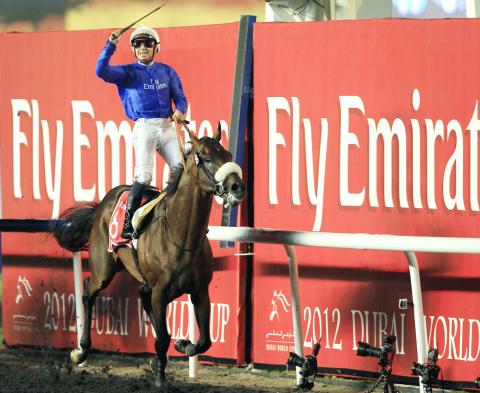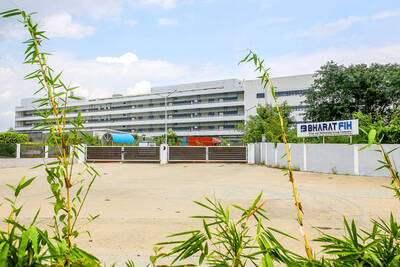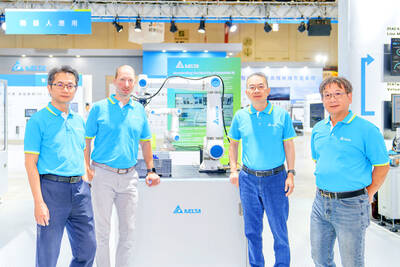When an economic crisis in Uruguay strained the finances of Pio Olascoaga Amaya’s family farm, he found salvation halfway across the world: the horse racing industry of Dubai.
Olascoaga took one of his horses from Uruguay to try his luck in an endurance race in Spain. After the horse finished third, he was able to sell it to a trainer working for Sheikh Mohammed bin Rashid Al Maktoum, Dubai’s ruler and an avid sponsor, owner and rider of horses.
That led to Olascoaga establishing business ties with Dubai and 10 years later, at the age of 31, he helps run a family business selling Uruguayan-reared horses with Arabian blood to the United Arab Emirates (UAE). He acts as an agent for other farms in Uruguay as well as his own farm, which has 600 horses.

Photo:Reuters
“If I sell a horse in Uruguay for let’s say US$20,000 on average, here you can sell at a minimum US$40,000,” he said.
The margin makes it worth paying the US$10,000 cost of transporting a horse by plane from Uruguay to Dubai, more than 17 hours away.
“Here in the UAE is the Formula One of horses. They need horses all the time and from all around the world,” Olascoaga said.
As the oil-rich Gulf economies boom, the hobbies of its wealthy local populations tend to become big business — and nowhere is that more true than for horses, a traditional passion of the region’s Bedouin tribes.
Dubai, with its large tourist sector and web of international transport links, has emerged as the focus of the horse business in the region. The business took a hit from 2009 to 2010, when Dubai was forced to restructure billions of US dollars of corporate debt, but has since bounced back with the local economy; the Dubai World Cup race, launched in 1996, attracted 65,000 spectators this year.
“This is something very important for Dubai, for tourism,” said Saeed H. al-Tayer, chairman of Meydan Group, which operates the opulent racecourse where the World Cup is held. He said the racecourse has a capacity of 85,000, but it could be expanded to 120,000 if needed.
The UAE is famous for endurance races across the desert by “drinkers of the wind,” as locals sometimes refer to Arabian horses. About 50 races of 80km to 240km are held in the cooler months between October and March.
About 2,000 active endurance horses and 87 racing stables are listed by the Emirates Equestrian Federation; which compares to about 800 such horses in France, where long-distance riding is also popular and which has a human population about eight times the size, data from the Federation Equestre Internationale shows.
Dubai is also a world power in flat racing; its annual World Cup in March is the world’s richest race with a US$10 million purse. The average flat race in the UAE during 2010 offered 100,073 euros (US$130,000) of prize money, the highest level in the world, according to the International Federation of Horseracing Authorities.
Even show jumping, historically more of a focus in Western countries, has been growing in the UAE. One recent -competition offered 260,000 dirhams (US$70,800) of prize money, while show jumping horses bought for as little as US$5,000 in Eastern Europe can fetch prices of US$80,000 in the UAE if they perform well.
Traditionally, Dubai’s wealthy have cherry-picked the world’s top horses at sales abroad. UAE Prime Minister Sheikh Mohammed was the biggest purchaser in an auction of two-year-old thoroughbreds last month at Europe’s largest auctioneer, Tattersalls of Britain.
He bought a colt sired by 2004 European Champion Shamardal for US$844,000, the third-highest price ever seen at the sale.
“We are used in the Emirates to picking the best horses in the world,” said Dubai First Deputy Prime Minister Sheikh Hamdan bin Rashid Al Maktoum, who owns about 1,000 horses around the globe, told the Dubai Racing television channel.
However, the industry is also supporting the development of home-grown businesses within the UAE. Several studs in the UAE breed pure Arabian horses, not only for races, but also for horse beauty contests, which are -popular across the Gulf Arab region.
“It is a very good business,” said Khalid Ghanem al-Omairi, general manager of the Ajman Stud, which belongs to the crown prince of Ajman, another of the UAE’s seven emirates.
“Every year we have about 35 mares for breeding, but out of these 30 to 35 you may get only three or four good ones,” said Omairi, whose stud has about 80 horses, some kept in the US and Germany.
Dubai’s Godolphin stable has made US$14.8 million in prize money so far this year. That brings the total to US$232 million since 1992.
In some ways, the economics of the horse business in the Gulf are difficult. In contrast to Europe, the desert terrain means the roughly 7,000 horses in the UAE have little chance to graze, pushing up owner’s costs. Hay is imported from as far away as Canada along with feed, tack and other products.
The UAE’s hot climate also means hooves grow faster, so a farrier has to change horseshoes every five weeks, one or two weeks earlier than in Europe, farrier Alexandre Chuette said. Grooms are paid as little as US$330 per month in the UAE because they can be hired easily from nearby low-wage countries such as India and Pakistan. However, monthly stable, feed and grooming costs typically range from US$650 to US$1,090 or more, compared to about US$450 to US$970 in Britain, people in the industry said.
Total annual costs of keeping a competition horse can top US$30,000, said Martina Boor, managing partner at Horseworld tack shop.
However, cost considerations are unlikely to sway the behavior of the affluent citizens of the UAE.
“I think that in the future, horse racing in Dubai and in the UAE will increase,” Dubai crown prince Sheikh Hamdan bin Mohammed Al Maktoum said after handing out trophies at a recent endurance race.

SETBACK: Apple’s India iPhone push has been disrupted after Foxconn recalled hundreds of Chinese engineers, amid Beijing’s attempts to curb tech transfers Apple Inc assembly partner Hon Hai Precision Industry Co (鴻海精密), also known internationally as Foxconn Technology Group (富士康科技集團), has recalled about 300 Chinese engineers from a factory in India, the latest setback for the iPhone maker’s push to rapidly expand in the country. The extraction of Chinese workers from the factory of Yuzhan Technology (India) Private Ltd, a Hon Hai component unit, in southern Tamil Nadu state, is the second such move in a few months. The company has started flying in Taiwanese engineers to replace staff leaving, people familiar with the matter said, asking not to be named, as the

The prices of gasoline and diesel at domestic fuel stations are to rise NT$0.1 and NT$0.4 per liter this week respectively, after international crude oil prices rose last week, CPC Corp, Taiwan (台灣中油) and Formosa Petrochemical Corp (台塑石化) announced yesterday. Effective today, gasoline prices at CPC and Formosa stations are to rise to NT$27.3, NT$28.8 and NT$30.8 per liter for 92, 95 and 98-octane unleaded gasoline respectively, the companies said in separate statements. The price of premium diesel is to rise to NT$26.2 per liter at CPC stations and NT$26 at Formosa pumps, they said. The announcements came after international crude oil prices

STABLE DEMAND: Delta supplies US clients in the aerospace, defense and machinery segments, and expects second-half sales to be similar to the first half Delta Electronics Inc (台達電) expects its US automation business to remain steady in the second half, with no signs of weakening client demand. With demand from US clients remaining solid, its performance in the second half is expected to be similar to that of the first half, Andy Liu (劉佳容), general manager of the company’s industrial automation business group, said on the sidelines of the Taiwan Automation Intelligence and Robot Show in Taipei on Wednesday. The company earlier reported that revenue from its automation business grew 7 percent year-on-year to NT$27.22 billion (US$889.98 million) in the first half, accounting for 11 percent

A German company is putting used electric vehicle batteries to new use by stacking them into fridge-size units that homes and businesses can use to store their excess solar and wind energy. This week, the company Voltfang — which means “catching volts” — opened its first industrial site in Aachen, Germany, near the Belgian and Dutch borders. With about 100 staff, Voltfang says it is the biggest facility of its kind in Europe in the budding sector of refurbishing lithium-ion batteries. Its CEO David Oudsandji hopes it would help Europe’s biggest economy ween itself off fossil fuels and increasingly rely on climate-friendly renewables. While